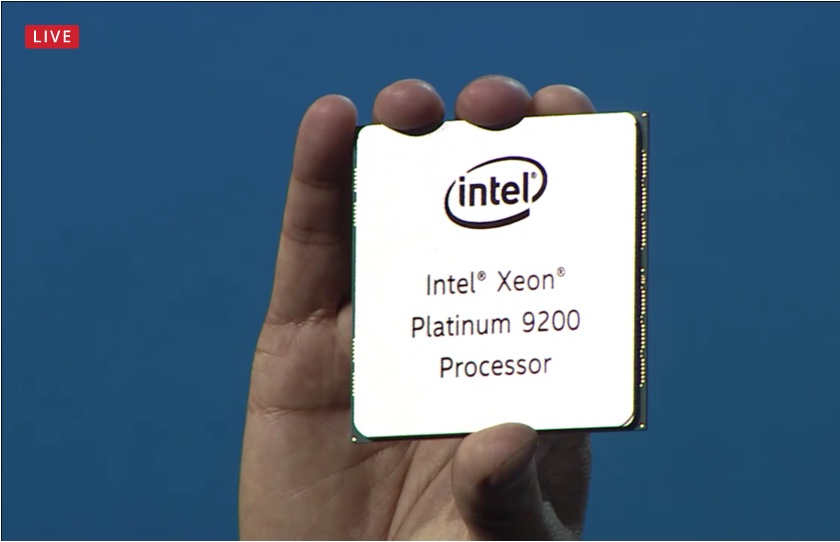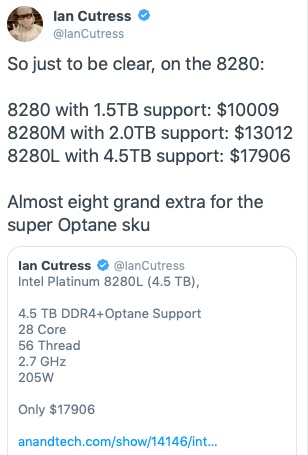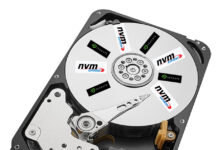As expected Intel has updated its Xeon processor line and shone a bright light on Optane DIMM (DC Persistent Memory) general availability.
It’s also announced a dual-port Optane SSD and a QLC (4bits/cell) ruler format drive.
Gen 2 Xeons
Intel has updated its Xeon CPU line to the Gen 2 Xeon Scalable Processors (SP) which were called the Cascade Lake line. The top end is the Platinum 9200 with up to 56 cores; 112 in a 2-socket system. There can be 12 channels of memory support with up to 4.5TB of Optane PMEM per socket.

Intel says there can be up to 36TB of system-level memory capacity in an 8-socket system when combined with traditional DRAM. That’s twice the normal (DRAM-only) system memory.
The Platinum 8200 has up to 28 cores and comes in 2, 4 and 8+ socket configurations. There are also Gold 6200s (to 24 cores), Gold 5200s (to 18 cores), Silver 4200s (12 cores) and Bronze 3200 series CPUs (to 8 cores).
Customers have to buy the Optane DIMM and then pay again for Optane support in the Xeon CPU. For example;

A Xeon Platinum 8280L can support 3TB of Optane and 1.5TB of DDR4 DRAM; that’s 4.5TB memory support, and it costs $17,906 whereas an 8280 with 1.5TB DRAM support only costs $10,009. The Optane costs an additional $7,897; eye-watering. Anandtech has more price and configuration details.
Intel’s also announced Xeon D-1600 SoC processors for network edge use. They have up to 8 cores.
It’s new Agilex FPGAs, built with 10nm process technology, also support Optane DC Persistent Memory and the Compute Express Link (CXL), Intel’s latest cache and memory coherent interconnect.
Optane DIMM endurance
Intel is still not releasing detailed Optane DIMM performance numbers. A Storage Review article says the 256GB module has an over 350PBW rating for 5 years at a 15W power level. A chart illustrates this and indicates a 360-370 PBW value.
Assuming a 360PBW value, that’s 72PB/year, 197.26TB/day or 770.5 write cycles a day, 281,250/year, and 1,406,250 over 5 years.
Dual-port Optane SSD and QLC ruler
Joining the single port P4800X is the dual-port Optane DC SSD D4800X (NVMe). Intel says it delivers 9x faster read latency compared to a NAND dual port SSD, under write pressure. No detailed performance numbers were provided.
Intel has also announced a QLC (4 bits/cell) 64-layer 3D NAND SSD, the D5-P4326 which uses the roughly 12-inch EDSFF ruler format to offer 15.36 and 30.72TB capacities. The 15.36TB capacity is also available in a U.2 form factor product. The 30.72TB ruler can enable 1PB of storage in a 1U chassis.
The random read/write IOPS are 580,000/11,000 and the sequential bandwidth is 3.2/1.6 GB/sec. Average read latency is 137μs. Its endurance is 0.18 drive writes per day (DWPD) for random I/O, and 0.9 DWPD for sequential I/O.
The claim is it enables HDD and TLC SSD replacement in warm storage. On eBay a 15.56TB ruler costs $3,920.39; $251.95/TB and $0.25/GB.

They join Intel’s existing 7.68TB QLC P4320 drive.
Gen 2 Xeon and Optane DIMM ecosystem
A raft of server and other suppliers is supporting the Gen 2 Xeons and Optane DIMMs; Cisco, Fujitsu, Supermicro and VMware to name a few.
VMware is supporting Optane DIMMs in “App-Direct” mode as well as “Memory” mode. vSphere is certifying the following maximum capacity for vSphere 6.7 release as follows:
- Up to 6TB for 2-socket and 12TB for 4-socket of Optane DC Persistent Memory in memory mode
- A combination of DRAM and Optane DC Persistent Memory in App-Direct mode with a combined limit of 6TB for 2-socket and 12TB for 4-socket
VMware vSAN will not have support for “App-Direct” mode at this time as cache or capacity tier devices of vSAN. Expect more developments to come.
Blocks & Files welcomes the dawning of the persistent memory era and notes that system and application software developments are needed before IT users will see the speed benefits. Bring it on.








